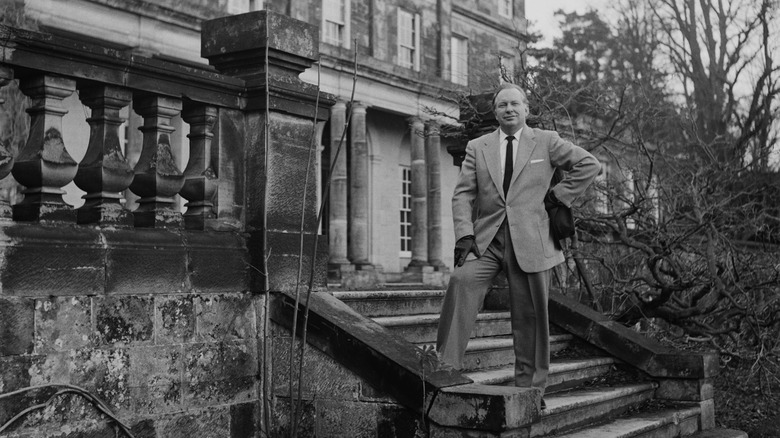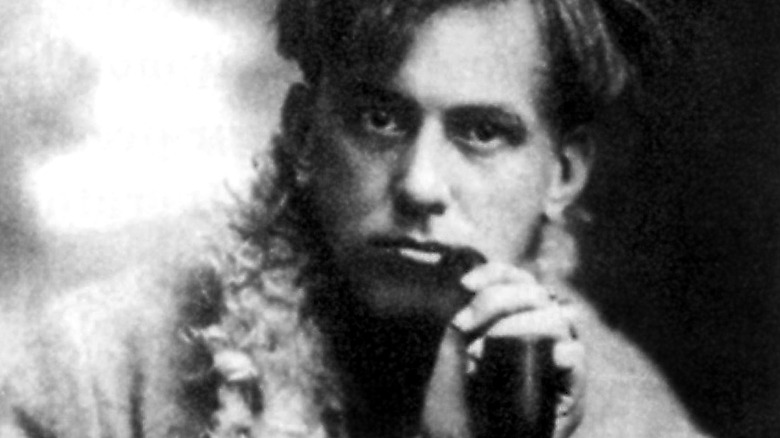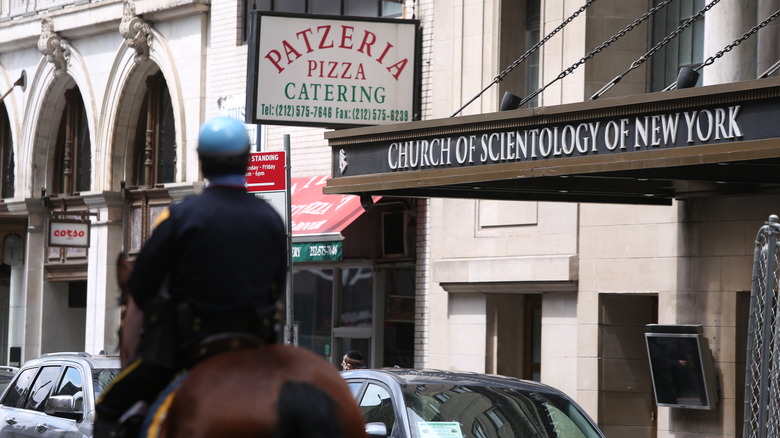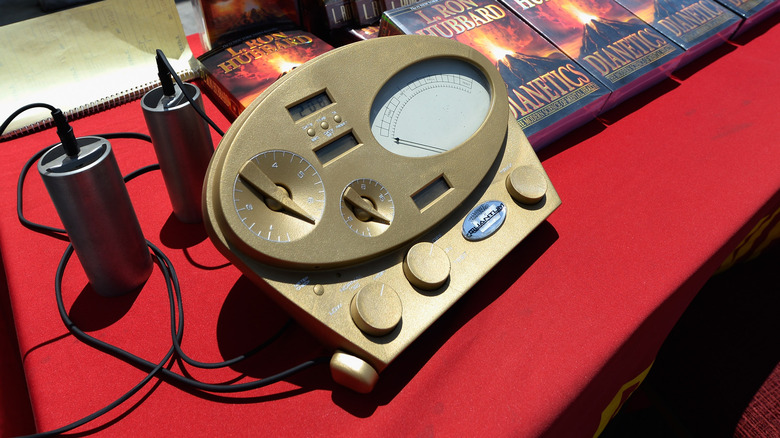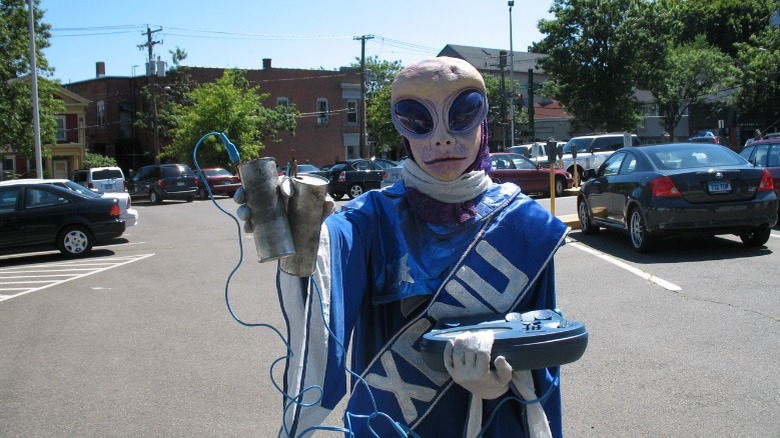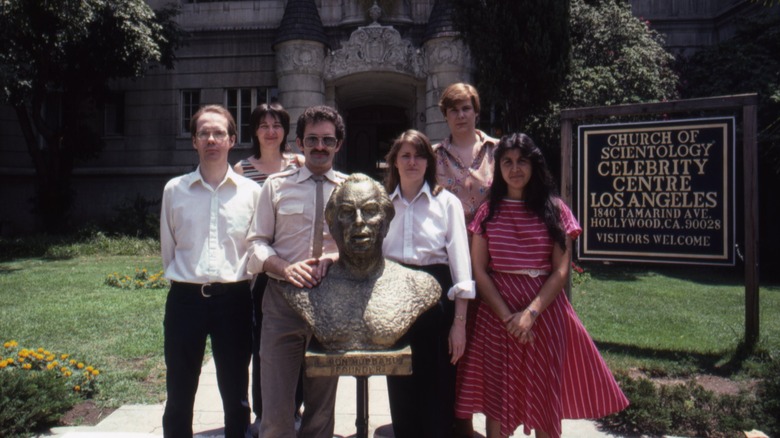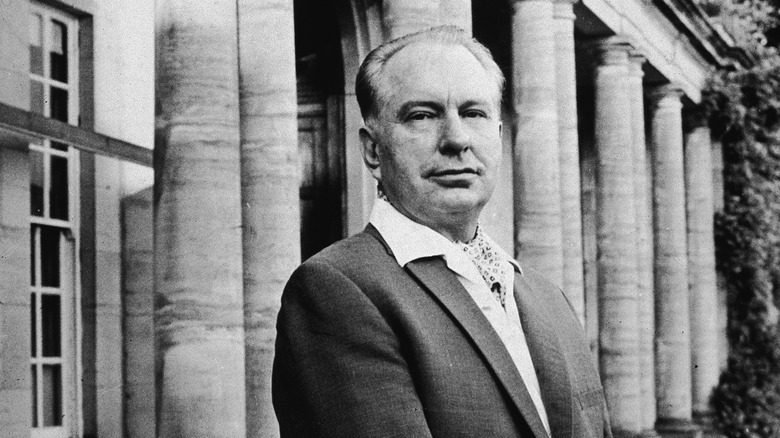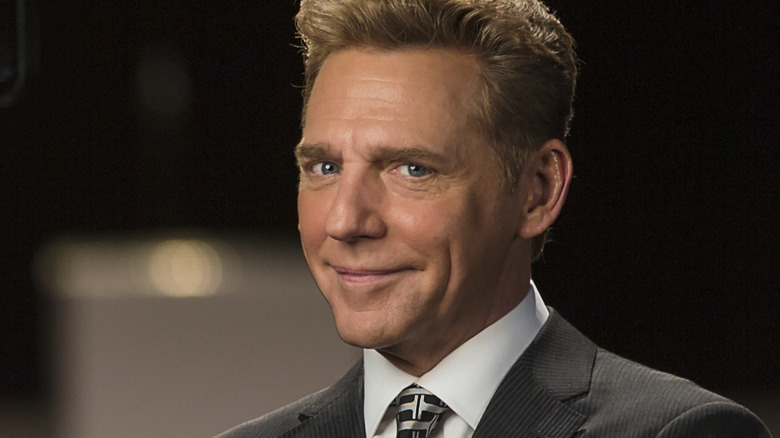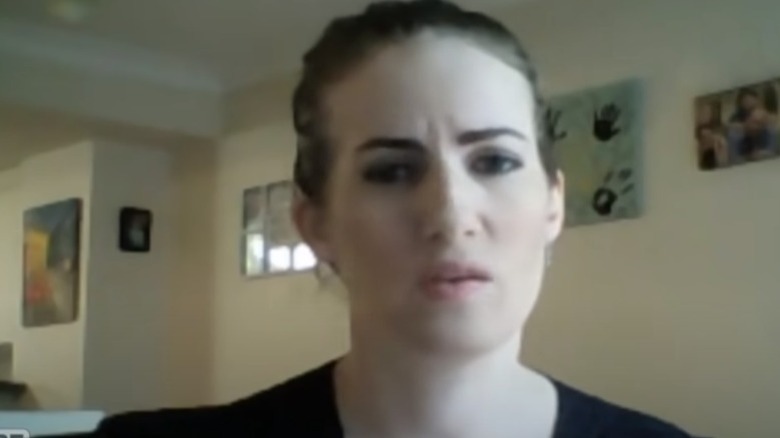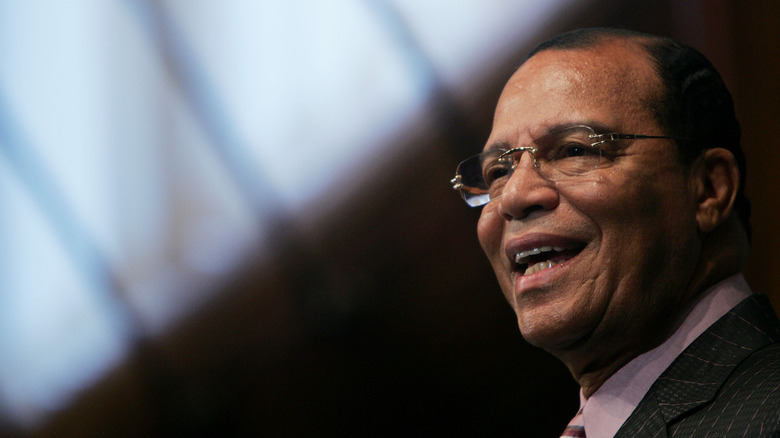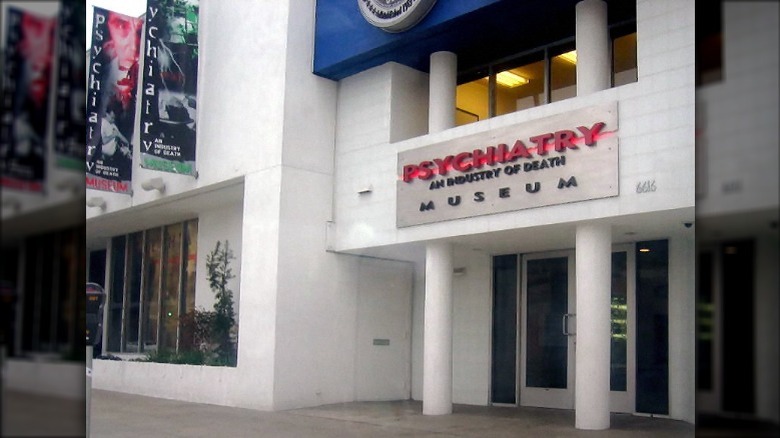16 Things About Scientology Most People Don't Realize
Scientology is a lot of things to a lot of different people. To some, it's a religion. To others, it's a way of life. And to others? It's a cult. According to Scientology itself, it's the belief that each and every person contains a spiritual, immortal being called a thetan. Each of the thetan's infinite lives consist of channeling a life force into eight dynamics, or drives: the self, sex, existence as part of a group, connection with all humankind, relationship with plants and animals, finding a place in the universe, understanding of the spiritual, and a connection with the infinite.
The entire thing was put together by sci-fi writer L. Ron Hubbard, who Time says incidentally once observed, "If a man really wanted to make a million dollars, the best way would be to start his own religion." After Hubbard's 1986 death following a stroke, the AP reported that the bulk of his fortune had been left to the church. Initially estimated to be between $280 and $600 million, the LA Times later reported that it was actually in the realm of $26 million ... in addition to what was left in undisclosed trust funds.
Scientology is insanely complicated: In a piece for the Marburg Journal of Religion, Phil Lord wrote that he spent 1,500 hours studying documents just on Scientology's legal system. He barely scratched the surface, so — that said — let's peel back some of the layers and see what we can learn about this polarizing group.
The origins of Scientology collide with Jet Propulsion Lab
NASA's Jet Propulsion Laboratory at Cal Tech does some ridiculously cool stuff, including building some of the most advanced equipment for space exploration. What's that have to do with Scientology?
It's an incredibly long story, but the short version is that JPL was founded by a brilliant yet eccentric chemist named Jack Parsons. Parsons, recounts Gizmodo, was also a follower of Aleister Crowley and a firm believer in the idea that he was destined to summon the human incarnation of a goddess named Babalon, who would, in turn, become the mother of the Antichrist. His assistant in all of this? L. Ron Hubbard.
Hubbard initially kept notes on all the sex magick rituals Parsons performed, but it wasn't long before he started hooking up with Parsons' girlfriend, Betty, on the side. Before jealousy ruined the whole thing, a woman named Marjorie Cameron showed up — and both Parsons and Hubbard became convinced she was Babalon. While Parsons and Cameron did their thing, Hubbard studied Crowley's organization Ordo Templi Orientis, and hatched a plan to make some cash by teaming up with Betty to sell boats. It was bankrolled by the last $20,000 Parsons had, and when it became clear that they had no intentions of following through with the plan, Parsons threatened to sue. Hubbard, in the meantime, was putting together the book called "Dianetics," and Parsons died in an accident involving explosives not long after it was published.
Scientology seems to lift a lot straight from Aleister Crowley
Official Church of Scientology doctrine does acknowledge L. Ron Hubbard's connection with Jack Parsons, Aleister Crowley, and Crowley's Ordo Templi Orientis. According to the church, Hubbard was actually part of a top-secret government mission to discredit Parsons and his beliefs, because they were "creating a national security situation."
They also say that Hubbard's work with Crowley has led to a series of misconceptions, but research done by Ohio State University's Hugh Urban suggests otherwise. Urban did a side-by-side comparison of Hubbard's Scientology writings and Crowley's work, and he suggests that Hubbard didn't even bother to try to hide the fact that he was lifting things wholesale. In fact, Urban says that when Hubbard started giving lectures around the release of "Dianetics," he described Scientology as a science-based continuation of Crowley's writing and an updated way of reaching the same end goal: tapping into a person's limitless abilities.
Where Crowley spoke of magic, Hubbard leaned on science — and some of the terminology is even inarguably similar. Where Hubbard uses the term "thetan" to refer to a person's immortal spirit, Crowley had talked about the "theta" as the product of a divine union. Scientology's eight-pointed cross bears a striking resemblance to Crowley's Golden Dawn cross, and ideas were similar, too. For example, Hubbard taught that the thetan could be separated from the body with practice, be sent on a tour of the universe, and act upon that universe to change and influence it — which echoes Crowley's magical teachings.
The lofty goals of auditing
Central to Scientology is auditing, and exactly what that is differs by who's answering the questions. According to their official doctrine, auditing is a type of interview where the auditor asks an individual or group a series of questions that are said to "help a person locate areas of spiritual distress, find out things about himself and improve his condition." When goals are met in one area, the process moves on to another.
However, some people who have left Scientology say it's not all about reaching your higher potential, and say there's something much more sinister going on here. John Sweeney is the author of "The Church of Fear: Inside The Weird World of Scientology," and says (via HuffPost) that a lot of the questions are about sex. From there, he suggests that it's just a short step to blackmail.
The Washington Post goes there, too, in their coverage of the Scientology documentary "Going Clear." The organization is upfront about the fact that not only do auditors take notes on each session, but they're recorded and videotaped as well. It wouldn't take much — in theory — to find secrets a certain Scientologist might not want to go public, and former Scientologist Mike Rinder says that's precisely what happens: "I used to do it when I was the head of the office of special affairs. By exposing [these secrets] or threatening to expose them, they will cower the person into silence."
What is the E-meter?
Auditing is done with the help of an E-meter: The auditor checks the readouts, while the person being audited holds two metal leads. Officially, Scientology says that the E-meter (or electropsychometer) is "a religious artifact used as a spiritual guide in auditing."
They go on to explain that Scientology teaches that the pictures seen by the mind's eye have both mass and energy, and when they're unpleasant, they can have a negative impact on the body that the thetan — a spirit — is currently inhabiting. The E-meter reportedly measures fluctuations in a person's energy, and these changes happen in response to mental pictures — allowing, in theory, the auditor to pinpoint problem areas in the psyche.
Vice says Scientology sells these E-meters to auditors, who buy them for around $5,000. They also say that even though they cracked down on the outside sale of E-meters, some have made it into public hands. That includes one example of a model that was used until about 2006, which was bought by a YouTube channel called Play with Junk. What did they find? In a nutshell, it measures skin contact resistance, which is how well electrical current moves through the skin (via the American Psychological Association). It's the same idea behind a polygraph test, and so: Is it worth a cool five grand? Not according to Play with Junk. They estimate the value to be around $200 ... give or take.
They say they walk the Bridge to Total Freedom
Scientology is essentially a series of courses that will allow a person to progress through levels called "The Bridge to Total Freedom." One of the most commonly talked-about terms in Scientology is "going clear," and according to ex-Scientologist Margery Wakefield (via "Understanding Scientology"), that's only at about the halfway point. Lower levels include phases like Grade 0, which is said to unlock the ability to talk to anyone about anything, and Grade 3, which reportedly frees a person from past failures, bad memories, and regret. Someone who is "Clear" is defined as "A being who no longer has his reactive mind," and from there, it's on to the other levels of OTI to OTVIII. Just what happens there is officially confidential.
Fortunately for non-Scientologists, journalist Tony Ortega has been investigating them for a long time — and has testimony from ex-Scientologists who are willing to explain the OT levels, or "Operating Thetan" levels.
Let's take one example (via The Underground Bunker): OTIII. Scientologists are told they'll go through "The Wall of Fire" in OTIII, and there's a massive build-up to what the devoted will gain access to at that level. What actually happens when you get there? According to those who have achieved it, you'll see what's in a locked briefcase: Hubbard's hand-written papers telling the story of Xenu, his 76-planet confederation, and how he created the thetans that inhabit every person on earth today.
Xenu and Scientology's origin story
In theory, someone has to progress through most of the levels of Scientology to get to the big reveal. Fortunately for the rest of us, Scientology has been around for so long that there are plenty of ex-Scientologists who are willing to spill the beans, like Claire Headley and Bruce Hines. They explained to journalist Tony Ortega (and The Underground Bunker) that it's a story Hubbard claimed to nearly have died investigating — and he added that he was the only one to survive in 75 million years of intergalactic history.
In a nutshell, Hubbard claimed that a being called Xenu had once led a 76-planet confederation. When those planets became overpopulated, he took the extra people, moved them to another planet (Teegeeack, or Earth), and then blew them all to bits with a hydrogen bomb. What remained were their souls, or thetans — and those thetans are filled with all kinds of terrible memories. They've also attached themselves to humans, and auditing is how they're purified of all the bad stuff they come with. Xenu, at least, has since been imprisoned.
Interestingly, Ortega has investigated why they believe the story about the evil alien (via The Village Voice). The answer is eerie: By the time they get there, they've spent years being audited. And during that auditing, they're walked through their past lives, where many people recall traveling through the universe for millions of years. By the time they get to OTIII, it's not something entirely new, it's something that explains what they've already been experiencing.
Exteriorization ... with the help of a .45
Lower levels of Scientology are really just working up to the fun stuff, which — according to ex-Scientologist Margery Wakefield (in "Understanding Scientology") — begins when a person goes Clear.
That, they're told, is when they're going to unlock powers of telekinesis and telepathy, as well as access to an IQ of at least 135, long-lasting health, unbreakable willpower, and an ability they call "exteriorization." As the name suggests, it's the ability to separate mind and body at will. It's this that's supposed to allow a person to control the world around them instead of reacting to it, and there are a few different exteriorization techniques taught.
In "Scientology: A Now Religion," George Malko writes that one is called R1-4, which is summed up by the phrase, "be three feet back of your head." There's another, too, and it's mentioned in "The Creation of Human Ability." It's called R2-.45, and according to Hubbard, it was the separation of mind and body with the help of a .45 pistol. The only note in the book about it is that it's kind of frowned upon, and while no one talks about it, it's said to be common knowledge. According to Time, Scientology's faithful say that he was just kidding.
The high cost of Scientology
Journalist Paulette Cooper wrote "The Scandal of Scientology" in 1971 (per AbeBooks), and one of the many things she learned was that going clear wasn't cheap. At the time, prices — which were variable — included a series of courses that would get someone to the clear state for around $4,625. Adjusted for inflation, that's around $32,000 in today's money (as of 2021).
Leah Remini's memoir "Troublemaker" got into some more recent costs. She said that going through to the higher levels — which could take around two decades, on average — was likely to cost the average person in the neighborhood of $500,000. She spent more than that in her 30 years in Scientology, estimating that she'd spent about $2 million on training, materials, and the like, and that she'd donated another $3 million to the cause. Expenses, she wrote, are expected: Scientologists are expected to purchase around 300 books, access to 3000 lectures, and take somewhere around 100 courses.
Then, there are surprise costs. When Remini left the Sea Org section of Scientology, she was told that courses that were free for Sea Org members needed to be paid for, now that she was no longer in it. At one point, she found herself being handed a $40,000 bill for snacks and sandwiches she'd eaten on the down low, while she was working in housekeeping at a Scientology facility for three months.
So, what happens when a Scientologist dies?
Officially, Scientologists don't believe in reincarnation, per se, but they do believe in past lives. The difference, they say, is that while a person who believes in reincarnation might believe they come back as an animal or other form of life, Scientologists say that souls will always return in human form. They also say that auditing will unlock memories of past lives, and dealing with ancient, past-life problems will allow progression in future lives.
L. Ron Hubbard got specific about just what happened to souls after the death of the physical body (via the Los Angeles Times). In a 1950s-era lecture, he explained that when the physical dies, the thetan inside goes to Venus, where it's reprogrammed for another life. (Hubbard himself claimed to have invented music in a past life when, 3 million years ago, he was living as a form called "Arpen Polo".) Then, the thetan is "capsuled and dumped in the gulf of lower California. Splash."
These thetans were left to wander until "you just eventually just pick up a baby," and if that all sounds pretty awful, that is kind of the point. There was, Hubbard explained, a way to skip the trip to Venus and decide where you wanted to be reborn — and Scientology could teach anyone who wanted to learn.
Hubbard's Fair Game law
In 2019, the Marburg Journal of Religion published a deep dive into Scientology's legal system, which they noted overruled and other legal systems for believers.
One of the things that they looked at was the Fair Game law, which was a 1965 creation of L. Ron Hubbard. In a nutshell, the law stated that anyone who was a non-believer was not protected by the umbrella of Scientology, and that anyone who actively tried to harm or interfere with the church was "fair game." For what? He wrote that anyone given the "fair game" designation could be "deprived of property or injured by any means by any Scientologist without any discipline of the Scientologist, [and] tricked, sued or lied to or destroyed."
Journalist Tony Ortega says (via The Underground Bunker) that it didn't take long for Scientology to find a target. That was Paulette Cooper, author of "The Scandal of Scientology." In addition to being the target of 19 separate lawsuits between 1969 and 1985, she has said she was also threatened with "exteriorization" via method R2-.45 ... i.e., a .45-caliber pistol. Scientology has claimed the law was overturned: Many ex-Scientologists say that it hasn't been.
Here's what reportedly happens in The Hole
A report in the Marburg Journal of Religion looked at Scientology's justice departments, and it's hardcore stuff. It includes bodies like the Committee of Evidence, which is a tribunal that judges anyone accused of breaking a law, and a series of correctional facilities that people might be sentenced to. That last part has reportedly only grown since the death of L. Ron Hubbard transferred church leadership to David Miscavige (pictured).
Church management lives and works on a property called Gold Base, and on Gold Base is a correctional facility called The Hole. (It's worth mentioning that Hubbard's vision of correctional facilities was called Rehabilitation Project Force, and it involved sentences of hard labor and study.)
According to the Tampa Bay Times, The Hole got started in 2003 when Miscavige started sending underperforming higher-ups to work in a double-wide trailer for months. Ex-Scientologists who were sent there describe terrible things, from unsanitary and inhumane living conditions to physical violence, abuse, and situations where members try to get others to confess to things in hopes of earning their own freedom. Bars went on the doors in 2004, along with locks. Some have testified that punishments included stuff like 30 minutes licking the bathroom floors, hours spent standing in garbage cans, crawling around on bare knees, and being doused with cold water. Scientology denies these accusations.
Scientology has a strange relationship with drugs
Officially, Scientology says drugs are a no-go, with the notable exception of antibiotics. Although their FAQ suggests that drugs that are prescribed by a medical professional are also allowable, ex-Scientologists say it's more complicated than that. Leah Remini, for instance, wrote in her memoir "Troublemaker" that when she gave birth to her daughter, she tried to do so without an epidural. Why? Scientology taught that the drug would make the baby's mind receptive to pain, and the mother's pain would transfer to the baby and stay there for their entire lifetime.
Kirstie Alley famously joined Scientology after crediting them with helping her to overcome her cocaine addiction (via the Los Angeles Times), and she's far from alone. Narconon is Scientology's treatment and addiction branch, and while it sounds admirable, it's been highly controversial. The Tampa Bay Times took a look at an investigation that kicked off in 2012, after the deaths of four people who were going there for treatment. While Scientology claimed there were other health issues in play, Narconon clinics started being shut down.
Then, in 2019, The Daily Beast reported that the family of one man — John Cunningham — had been awarded an $11 million settlement. He had been enrolled in a Narconon facility called Redwood Cliffs by a family member who had no idea it was associated with Scientology, and their legal team argued that "L. Ron Hubbard's drug/alcohol addiction and rehabilitation philosophy is antagonistic to conventional medicine." The courts agreed.
There are two very different version of what happens on Scientology's cruise ship
The official version of what happens on the Church of Scientology's cruise ship called the Freewinds, well, sounds pretty amazing. Scientology calls it a "religious retreat [on the] journey to total spiritual freedom." It's marketed as the sort of ship where, once you're on board, you're sort of wrapped in a blanket of peace, tranquility, and enlightenment.
Like many aspects of Scientology, there's another side to the story. Hugh Urban, author of "The Church of Scientology: A History of a New Religion," says (via CNN) that the Freewinds is one of a fleet of ships that was a response to early Scientologists getting kicked out of entire countries, like England. Out in the open ocean, though, there was no oversight — and Scientology was free to do as they pleased. It's also the only place members can attain the elusive OTVIII level, but others tell a dark tale of the high seas.
In 2011, Australia's ABC News reported on the story of Valeska Paris (pictured), who claimed she had been sent to the Freewinds by Scientology head David Miscavige. Her mother had planned on leaving the church with her, and Paris said that the response was to keep her on the ship — for 12 years. Laura Baxter told The Sydney Morning Herald that being locked in the extreme heat of the engine room was a punishment, and one she received for spending too much time talking to Tom Cruise. She claimed that she had been kept there for months.
Scientology did damage control by reaching out to the Nation of Islam
The Nation of Islam was founded way back in 1930, and the Southern Poverty Law Center designates it a hate group for their antisemitic, anti-LGBTQ+, and anti-white rhetoric. They've also developed close ties with Scientology.
It started, says The New Republic, with sort of a perfect storm. In the mid-2000s, membership in Scientology was down to around half of what it had been at the beginning of the decade. It was also about the same time that a Nation of Islam minister turned to Scientology in despair over the surge in violence happening in Los Angeles. He got in deep, got the attention of the head of the Nation of Islam, Louis Farrakhan, and Farrakhan reached out to Scientology.
By 2010, Scientology was inducting Nation of Islam members at mass events, with insiders saying that Farrakhan had aligned the two by telling his followers that Scientology's methods of going clear were exactly what Black America needed to overcome centuries of oppression. Naysayers — like Nation of Islam assistant minister Ishmael Bey — take particular issue with the "pay-as-you-go religion" setting up in historically poor, Black communities, relying on a devotion to Farrakhan to keep people returning to the well of Scientology. Bey explained: "It has never cared about African-Americans ... These are poor people and they are being exploited."
Scientology vs. psychiatry
Scientology famously stands in opposition to mainstream psychiatric treatment, and their official stance is that the "wholesale diagnoses of mental disorders [and] marketing of antidepressants [in] nightmarish proportions [is] an elaborate and deadly hoax." The belief is that it's a massive lie designed to funnel a fortune into the psychiatry and pharmaceutical industries, and that it's human abuse on a gigantic scale.
The Daily Beast suggests their stance on psychiatry is even more extreme than it sounds. Los Angeles's Sunset Boulevard is home to a museum called "Psychiatry: An Industry of Death," and despite it being labeled as an exhibit put together by an organization called the Citizen's Commission on Human Rights (CCHR), it declines to mention it's a multi-million-dollar venue funded by the Church of Scientology.
CCHR is also Scientology-run, and their museum lays out some serious allegations, claiming that everything from the Holocaust and school shootings to rape is the fault of the psychiatric industry. Exhibits claim to connect world events to the conspiracy, too: 9/11, they say, was a conspiracy to traumatize an entire nation and, in turn, sell more antidepressants. While the museum doesn't offer alternative treatments, Scientology does. They include, for example, confining a person having a mental health crisis in complete isolation. That happened to Lisa McPherson in the mid-1990s: She died after reportedly being denied water for between five and 10 days.
Where is Shelly Miscavige?
After L. Ron Hubbard's death in 1986, Scientology got a new boss: David Miscavige. He was, at the time, married to Shelly Miscavige, but Vanity Fair says that it was in August of 2007 that she just disappeared.
Among those who haven't given up trying to find out what happened to her is Scientology defector Leah Remini. Early on, most of her inquiries were met with the sort of explanations given by someone who doesn't want to go to a party: She was visiting a sick family member, or she was working on a special work project. Remini filed an official missing persons report, and it was closed with no real explanation. David and Shelly had been a couple for a long, long time — they met when she was just 15 years old, and once they started dating, they were on their way to Scientology greatness: Those who knew her say she was completely devoted to the cause.
Questions about her whereabouts are raised every so often, and in 2022, Remini dropped a massive bombshell on Twitter. She claimed that the person she filed her missing persons report with — LAPD Captain Cory Palka — was on the receiving end of donations given to the LAPD from Scientology — and, she adds, he had assigned people specifically to give Scientology whatever help they needed with whatever problems they had. That led her to demand an outside investigation into the relationship between the LAPD and Scientology, ending her series of tweets with, "WHERE IS SHELLY???"

